A Biography of Britain's Iconic Monarch, Queen Victoria
Childhood and the Ascension to the Crown
Birth and Early Life
Alexandrina Victoria was born in London's Kensington Palace on May 24, 1819. Princess Victoria of Saxe-Coburg-Saalfeld and Prince Edward, Duke of Kent, had only one child. Her mother and Sir John Conroy, her advisor, kept her under rigorous supervision when her father passed away when she was a baby.
Taking the throne
Victoria was fifth in line for the crown at birth. But she became the heir to King William IV after her father and uncles passed away. Victoria, then eighteen, was crowned Queen of the United Kingdom after his death in 1837. Political conflicts and the influence of her mother and advisors were among the difficulties she faced during her early years as queen. But she soon made a name for herself as a powerful and self-governing monarch.
The reign of Queen Victoria (1837–1901)
The Growth of the Empire of Britain
Britain rose to become the world's most powerful empire under Victoria's leadership, gaining the moniker "The Empire on which the sun never sets." Victoria became the Empress of India in 1877 as the empire spread into India, Africa, Canada, Australia, and the Caribbean.
Developments in Industry and Science
During Victoria's reign, the Industrial Revolution blossomed, resulting in:
The growth of steamships and railroads Scientific and medical breakthroughs The expansion of factories and cities
The Great Exhibition of 1851, which presented the globe with Britain's advances
Political shifts and social reforms
Significant political changes occurred in Victoria, including:
The repeal of laws pertaining to child labour
Voting rights expansion (Reform Acts of 1867 and 1884)
Growing middle-class populations and advancements in education
As her reign came to an end, the women's suffrage movement gained strength.
Victoria, who adhered to traditional gender norms, rejected women's rights in spite of these developments.
Personal Life: Family and Marriage
The Family Tree of Queen Victoria
Grandparents and parents
Father: Duke of Kent Prince Edward (1767-1820)
Mother: Saxe-Coburg-Saalfeld Princess Victoria (1786–1861)
King George III and Queen Charlotte are the paternal grandparents.
Francis, Duke of Saxe-Coburg-Saalfeld, and Countess Augusta of Reuss-Ebersdorf were the maternal grandparents.
Getting married to Prince Albert
Queen Victoria wed Prince Albert of Saxe-Coburg and Gotha, a relative, in 1840. They had nine children together, and their marriage was founded on respect and love. Albert was instrumental in advising Victoria and influencing British culture, particularly in the areas of industrialisation and education.
Victoria's mourning and Prince Albert's passing
Victoria was grieved when Prince Albert passed away from typhoid sickness in 1861. For many years, she avoided public life, dressing in black for grief and becoming known as "The Widow of Windsor." Her popularity waned during this time, but with the support of her advisors, she finally returned to public life.
Difficulties and Later Years
Crises in politics and attempts at assassination
Despite surviving several assassination attempts during her reign, Victoria remained dedicated to her position. She balanced British political rivalries by collaborating closely with prime ministers such as William Gladstone, Benjamin Disraeli, and Lord Melbourne.
The Famine in Ireland (1845–1852)
The Great Famine in Ireland, which claimed the lives of over a million people, was one of the worst catastrophes that occurred during her rule. Victoria made a donation to aid operations, but her administration came under fire for her tardiness.
Boer Conflicts and British Growth
Victoria backed British military operations in Africa towards the end of her reign, including as the contentious Boer Wars (1899–1902), which demonstrated Britain's military superiority.
Death and Legacy
Funeral and Death
At the age of 81, Queen Victoria passed away at Osborne House on the Isle of Wight on January 22, 1901. She was interred next to Prince Albert in Windsor's Frogmore Mausoleum after a state burial on February 2, 1901.
Queen Victoria's legacy
Britain and the world were impacted in a lasting way by Queen Victoria's reign:
She represented power and stability at a period of swift change. She reduced the political power of the king and shaped the present constitutional monarchy. As a result of her offspring marrying into European royal families, she became known as the "Grandmother of Europe." The literature, architecture, and moral principles of the Victorian era still have an impact on culture today. The Edwardian Era began when her son, King Edward VII, replaced her.
Interesting Queen Victoria Facts
1. She was the British monarch with the second-longest reign.
Queen Victoria was the second-longest reigning British monarch after Queen Elizabeth II, ruling for 63 years and 216 days (1837–1901).
2. She asked Prince Albert to marry her.
Prince Albert was not as high in the royal hierarchy as Queen Victoria. Royal custom dictated that she had to ask him to marry her, not the other way around.
3. She Overcame Several Attempts at Assassination
Victoria survived at least eight assassination attempts during her reign, including assaults and bullets while riding in her carriage.

